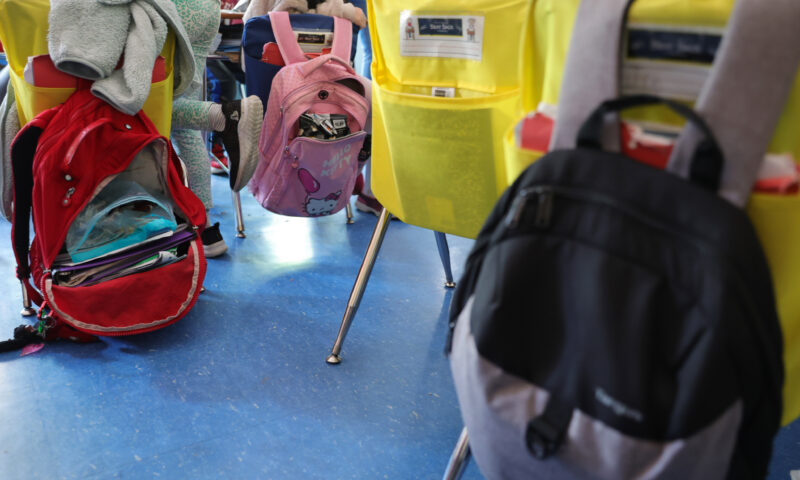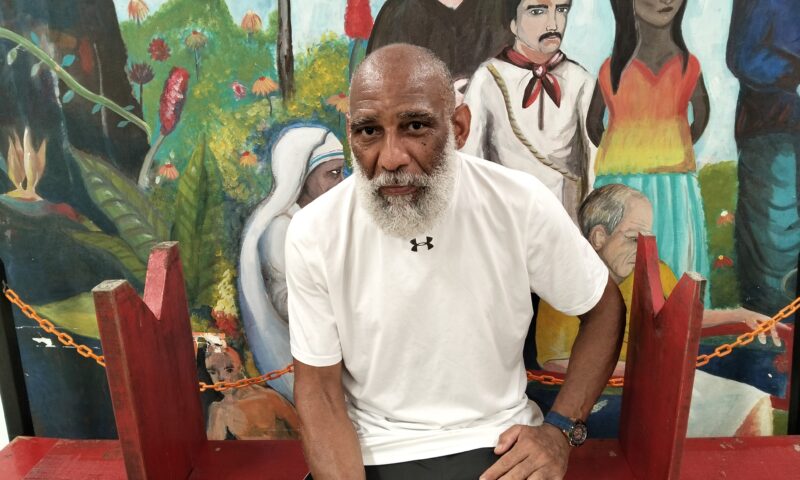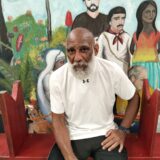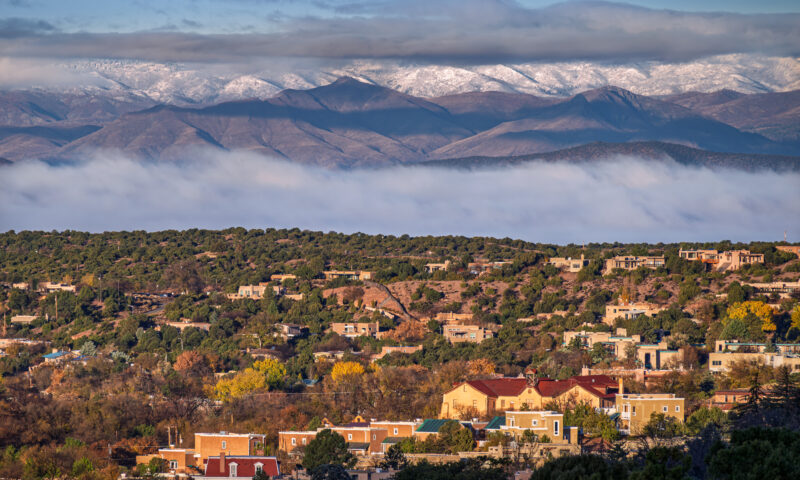Beyond the Border brings you human stories about the U.S. immigration system through original reporting from journalist Kate Morrissey and curated highlights from reporters across the country. The newsletter is supported by Capital & Main.
As the oldest migrant shelter in Tijuana prepares to celebrate its 38-year anniversary this week, its director is scrambling to budget for its continued operation.
Casa del Migrante, an unassuming green and tan building perched on a hillside in the city’s Colonia Postal, has supported people on the move since 1987. This year, according to its director, the Rev. Patrick Murphy, 40% of its budget would’ve come from grants funded through money from the U.S. Agency for International Development.
Earlier this year, the Trump administration slashed that funding.
Murphy, 73, known affectionately to many as “Father Pat,” said he’s having to downsize his team.
“Only God knows what will come next,” Murphy said. “The next three years, eight months, I’m not planning on anything good happening.”
Murphy has steered the shelter since 2013, moving from a parish in Kansas that served a Spanish-speaking community largely from Michoacán, Mexico. When he arrived in Tijuana he found that many of the people he was serving were also from Michoacán, according to reporting at the time from The San Diego Union-Tribune.
When the Rev. Florenzo Rigoni founded the shelter, it primarily served deportees coming back to Mexico, Murphy said. Murphy did a brief stint as acting director of the shelter in the early ’90s and returned in 2013 to run the refuge. Even then, it still mostly received men returning south after the U.S. deported them, he said.
The shelter encouraged the new arrivals to find work and rebuild their lives in Mexico. It still has programs today to help migrants make new homes in Tijuana through job training classes, but the demographic it serves has shifted dramatically during Murphy’s time at the shelter.
In 2016, Haitians, who had mostly been living in Brazil since a 2010 earthquake demolished much of the infrastructure in their home country, began arriving in significant numbers at the San Ysidro Port of Entry that connects San Diego and Tijuana. Murphy said Mexican immigration officials called him, asking if he could help.
Mexican officials gave out appointment dates to the arriving Haitians, coordinating with U.S. Customs and Border Protection to control how many entered the U.S. each day.
He recalled spending Christmas that year with the shelter full of Haitians, but that moment to him represented a bigger shift. He calls it “when the entire world arrived.”
Who is arriving, and what they encounter when they get to the border, hasn’t stopped changing since then.
“We adapt to the migrant,” Murphy said. “We don’t ask the migrant to adapt to us.”

The Rev. Patrick Murphy, director of Casa del Migrante. Photo: Kate Morrissey.
Casa del Migrante began primarily helping asylum seekers. Families arrived in Tijuana from southern Mexico and Central America, and adults, mostly men, arrived from African and Asian countries including Cameroon and Eritrea.
At that time, Casa del Migrante housed only men. Their wives and children would often stay in a shelter up the street called Instituto Madre Asunta.
It was in 2017 that a line of asylum seekers formed at the San Ysidro Port of Entry that wouldn’t disappear until the pandemic closed down asylum processing at the border altogether. Customs and Border Protection officers, in a policy known as “metering,” restricted how many asylum seekers could cross onto U.S. soil. They sent the rest away to wait for another day.
In early 2018, migrants began using a notebook to track who was next in line. Asylum seekers would wait in the growing number of shelters around the city for their turn to request protection. That year, caravans of Central Americans arrived in Tijuana, and Casa del Migrante filled with people from Honduras, El Salvador and Guatemala, Murphy said.
The pandemic changed migration patterns again. Murphy said he closed entry to the shelter for about two months and stayed there with about 50 people who decided to wait and see what would happen. The Trump administration used the spread of COVID-19 as its reason to completely stop processing asylum seekers, under a policy called Title 42.
As the world opened back up, Murphy said he decided it was time for the shelter to start taking in full families, not just single men. Casa del Migrante created programs for children and helped its young residents attend school.
As the Biden administration ended Title 42, it introduced a phone application called CBP One that gave out appointments, lottery style, to asylum seekers wanting to cross into the U.S. At the same time, the administration restricted migrants’ ability to win asylum cases if they entered the country without using the app.
“That changed the face of the Casa enormously,” Murphy said. “They come on a Monday. Their appointment was on Thursday, and they would stay, and we’d give the hospitality, and then they go to the appointment, and then that was it.”
On Jan. 20, 2025, a family left Casa del Migrante for a CBP One appointment, but at the port of entry, officials said that all appointments were cancelled. Since then, the Trump administration has closed asylum processing at the border again.
Many have left the shelter, and deportations are more often happening by plane to southern Mexico than on foot over the land border, Murphy said. Witness at the Border, a group that monitors deportation flights, reported that the U.S. sent 22 flights to southern Mexico in March.
“Ironically, we were planning to see how we could expand hospitality at the border for all the immigrants that would be deported here,” Murphy said.
Now, he said, it’s time for the shelter to figure out how to adapt again so that it can best serve the people who need it.
“I’ve been knocking on doors of churches and knocking on doors of friends,” Murphy said. “And people have responded well. So that’s the good news. Still, people want to help.”
He stays motivated by the people he serves, especially the children who now live at the shelter, he said.
“I see a good person have success, whether it’s getting a job, a life in Tijuana or crossing the border — it gives me hope that we’re making a difference in people’s lives,” Murphy said.
One man in particular stands out to Murphy.
The man’s brother, who lives in Murphy’s old parish in Kansas, called a few years ago to ask for help. The man had been deported and wasn’t doing well, Murphy said.
With support from Casa del Migrante, the man stabilized his life, found work as a mechanic and was able to rent a place of his own. He still comes to the shelter at night for a meal and to church on Sundays, Murphy said.
“I think he also comes for the companionship,” Murphy said, “and when he’s here, he never fails to come up and shake my hand.”
Other Stories to Watch
I’ve had several conversations recently with people who have worked on the border for years, and they have had me thinking about how we got to where we are today. My interview with Murphy offers some of that lookback. If you want to go deeper, I wrote a piece last week for Prism about metering, a lawsuit that challenged it and what life is like for the plaintiffs who have to keep moving their lives forward while these immigration policy challenges play out in court.
In another piece showing the connections between past and present, I wrote for Capital & Main last week about Russians who were sent to long term immigration detention facilities under Biden, and now, even though judges granted them asylum in immigration courts, they are still being held in custody by the Trump administration.
The Department of Homeland Security sent mass emails last week to immigrants who entered the U.S. through a CBP One appointment. The emails said that the department was revoking their permission to be in the country and that they needed to leave immediately. Several attorneys and other legal advocates who are U.S. citizens by birth have reported also receiving these emails directing them to leave the country immediately. A U.S. citizen physician also said she received one of these emails.
The U.S. Northern Command said on Monday that its troops will begin detaining people in an area of the New Mexico border now under military control. This follows a presidential memo on Friday that transferred a 60-foot-wide strip of land, which stretches from New Mexico to California, to the U.S. Army. It seems to be an attempt to get around the restrictions normally in place regarding military troops doing civilian law enforcement on U.S. soil. It’s still unclear what parts of Texas might also be included in the memo, according to the Border Chronicle.
Immigration officials last week detained another Columbia University student who participated in protests against Israel’s attacks on Gaza, this time at an interview appointment that he believed was part of his process to become a U.S. citizen. Another student targeted by Immigration and Customs Enforcement at that school told Jewish Currents that the university withdrew her enrollment after the U.S. government cancelled her visa. That student fled to Canada.
A Massachusetts woman recorded immigration officials using a large hammer to break the window of her car to arrest her husband last week. Her husband is from Guatemala and is in the process of adjusting his immigration status, the family’s attorney told reporters.
An attorney shared a video of him confronting immigration officials outside his teenage client’s home. The officials said they were conducting a welfare check, but the attorney did not believe them. Similar welfare check claims are popping up in California as officials show up at the homes and schools of children who entered the U.S. without their parents, including in Los Angeles and San Diego.
In early March, I wrote about how conditions in detention centers are deteriorating as the Trump administration holds more people in immigration custody. More recent reporting from The Washington Post shows those conditions are only getting worse. The agency appears to be breaking its own custody rules and keeping people in cells for days without access to beds or showers, according to The Nation.
A U.S. citizen was arrested in Florida and accused of being undocumented. He stayed in custody even after his mother showed a judge his birth certificate from the state of Georgia. He has now been released.
High Country News looks at the history of Spanish-language radio offering support to its listeners regarding immigration enforcement and what stations are doing now to inform people of their rights.
A federal judge last week temporarily blocked the Trump administration from reimplementing the “Remain in Mexico” program, which, during the president’s first term, required asylum seekers to wait south of the border while their U.S. immigration court cases proceeded. It’s not clear how many people have been placed in the program since Trump returned to office and restarted it.
The Trump administration sent 10 more people to a Salvadoran prison last week amid legal challenges to its use of the Alien Enemies Act to remove Venezuelans from the U.S. without hearings, Secretary of State Marco Rubio said on X.
Meanwhile, Salvadoran President Nayib Bukele visited the White House, and journalists at Salvadoran outlet El Faro looked at the ways that the Trump administration might be following in his footsteps in terms of defying court orders in order to consolidate power. On Sunday, Bukele posted on social media that he would be willing to release the 252 Venezuelans held in Salvadoran custody if Venezuela releases an identical number of political prisoners.


 Latest NewsNovember 19, 2025
Latest NewsNovember 19, 2025
 Latest NewsNovember 18, 2025
Latest NewsNovember 18, 2025
 The SlickNovember 18, 2025
The SlickNovember 18, 2025
 Latest NewsNovember 17, 2025
Latest NewsNovember 17, 2025
 Column - State of InequalityNovember 21, 2025
Column - State of InequalityNovember 21, 2025
 StrandedNovember 25, 2025
StrandedNovember 25, 2025
 Column - State of InequalityNovember 28, 2025
Column - State of InequalityNovember 28, 2025
 The SlickNovember 24, 2025
The SlickNovember 24, 2025


